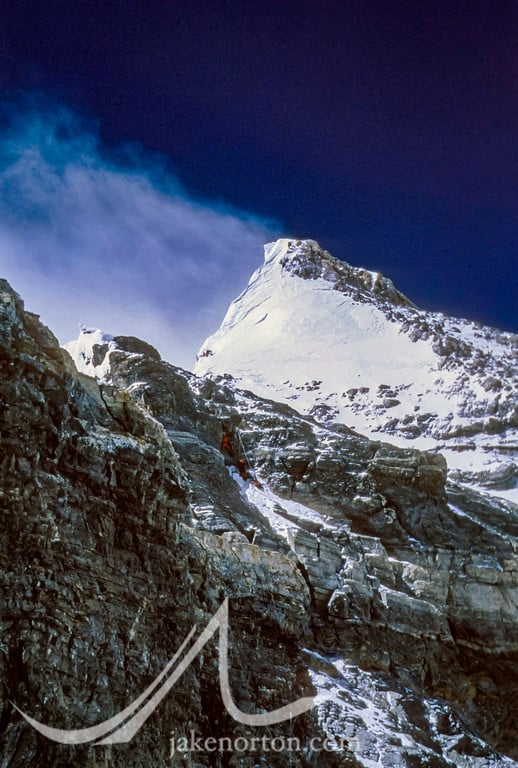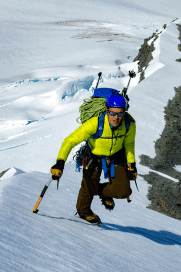I’ve been slowly having my archive of slides – some 15,000 from past shoots and expeditions – scanned by ScanCafe. The last shipment just came in recently, and included my images from the first Mallory & Irvine Research Expedition in 1999.
Wow…Lots of images, taken on my first trip to Everest, and many I had all but forgotten as they gathered dust in my filing cabinets. As I sifted through the thousands of images, I came upon a shot I took on May 17, 1999, from above Mushroom Rock. It shows the view of the Second Step as Conrad Anker attempted to free climb it, belayed by Dave Hahn.

The image shows a neat perspective, rarely seen, of the Second Step, and why I think the question of whether or not George Mallory could have free climbed it in 1924 is something of a red herring.
In Part III of my series a year ago about the mystery of Mallory & Irvine, I noted the oft-forgotten but previously popular technique of courte-échelle. Basically, a lead climber would stand on the shoulders – and even head – of another to tackle a short-but-difficult section of rock. (There is a wonderful photo of Albert Ellingwood and Carl Blaurock using the technique on a piece of rock in Colorado in the 1920’s; note that the rock in this image is similar in height to that of the Second Step headwall.)
Well, to my point here, the photo I just re-discovered from 1999 pretty clearly shows that had Dave Hahn moved upward to the top of the snow bench and given Conrad Anker a courte-échelle, Conrad would have been able to reach the easier rock of the upper Second Step and probably pull over the top. As noted previously, that’s exactly what Qu Yinhua did on the Chinese expedition in 1960. And, I believe, it is likely what George Mallory and Andrew Irvine did on June 8, 1924.
While free climbing the Second Step is an amazing, impressive feat, it’s perhaps not relevant to the question of Mallory and Irvine’s attempt on the summit in 1924.



I enjoyed reading your analysis of In 1986 I was part of an American expedition that attempted to repeat the 1984 Australian route through the Great Couloir (Norton Couloir) Unfortunately we never got higher than the base of the couloir at about 25,000 feet. I offer a thought I had years ago when Mallory's body was found--the significance of his watch being in his pocket. When climbing in the mountains and especially the big mountains, I always carried a watch to keep track of progress vs plan, when to turn around, etc. But when climbing an offwidth, even for a move or two, I took it off because an offwidth would almost always damage the watch. The fact that he had it in his pocket suggested that he had encountered an offwidth, and the second step is the only one I know of in that route. I think your insight about their possible use of a shoulder stand is to facilitate that problem is certainly plausible, as that was, I believe, a standard maneuver at that time. Although the standards of technical difficulty in rock climbing jumped dramatically in the fifties and sixties, due to sticky rubber shoes, better (reusable steel pitons) and synthetic ropes, we must recognize that wide crack climbing was done at a pretty high standard early in the 20th century. eg Oliver Perry Smith http://www128.pair.com/r3d4k7/HistoricalClimbingImages3.1.html, so it is at least quite possible that Mallory would have attacked that crack in the second step, plausibly in the way you suggest.
Hi Brinton,
Thanks for your comment and thoughts. That was an impressive team you were with back in '86 on the Couloir - a route I've always looked at longingly! And, great point about the watch in his pocket and the off-width. I tend to run and hide from off-widths if at all possible, but like you would always take off my watch, bracelet, etc. before even thinking about climbing/attempting to climb one. And, yes, the Second Step is the only off-width I know of that would be logical to hit on the mountain.
And, totally agree with your thoughts on the shoulder stand technique, and the fact that we so often fail to account for the skill of the early climbers on rock in general, and cracks in particular. Those shots you shared are amazing - thank you!
The first book I ever bought was “Ghosts of Everest”. After the recent discovery of Irvine’s boot, my imagination is re-ignited on this subject. Thank you so much Jake for your work, and obsession. I’ve been with you for years, as many others have!
Cheers
Thank you, Nick - so very appreciated! Eager to hear more about this discovery when they release more detail. I added a post on my thoughts here - let me know what you think!